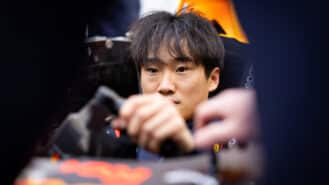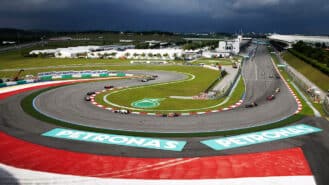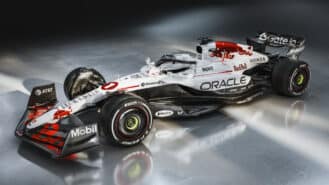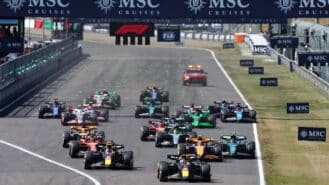
Tsunoda reveals Red Bull expectations after Lawson swap
Yuki Tsunoda has explained the performance level Red Bull is demanding as he joins the F1 team — and says that he will be allowed to beat Max Verstappen if he's quick enough
Looking back 50 years ago to 1966 it’s abundantly clear that it was truly a seminal year for motor racing as a whole and American racing in particular. It was, of course, the year of Formula 1’s ‘return to power’ with three-litre engines arriving after five years of the tiddly 1.5-litre formula.
But in America a whole raft of things took place that marked the year as one of the most important in the sport’s history.
Click here to buy the lead image.
To begin, the original unlimited Can-Am series was launched in the fall of 1966 with a six-race championship at St. Jovite, Bridgehampton, Mosport, Laguna Seca, Riverside and Stardust Raceway in Las Vegas. Can-Am immediately established itself as one of international racing’s leading championships with more prize money than Formula 1 and big, powerful, noisy cars driven by some of the top F1 stars as well as America’s best road racers and a few top oval racers too.
The inaugural Can-Am championship in 1966 was taken by John Surtees who won three races aboard his factory-backed Team Surtees Lola T70-Chevy. The other Can-Am race winners in ’66 were Dan Gurney, Mark Donohue and Phil Hill, three of America’s greatest racers.
At Bridgehampton, driving his own All American Racers’ Lola T70, Gurney scored Ford’s only win during the nine years of the original Can-Am’s short-but-spectacular life. Donohue recorded his and Penske Racing’s first Can-Am win at Mosport a few weeks later aboard a Penske/Sunoco Lola T70-Chevy while 1961 F1 World Champion Phil Hill scored Chaparral’s only Can-Am victory at Laguna Seca where he and team owner Jim Hall finished one-two driving a pair of high-winged Chaparral 2Es.
Hill also recorded a pair of long-distance sports car wins for Chaparral in 1966 and ’67. Phil co-drove a 2D with Jo Bonnier to win the Nürburgring 1000Kms in 1966 and shared a high-winged 2F with Mike Spence to win the Brands Hatch 6 hours in 1967, the final race of Hill’s career.
Bruce McLaren and Chris Amon’s factory McLaren M6B-Chevies were shut-out of winning any races in the ’66 Can-Am, but the McLaren team came back to dominate the series over the following five years as the ‘Bruce and Denny Show’ arrived. Bruce won the Can-Am title in 1967 and ’69 with Denny Hulme taking the 1968 and ’70 championships and Peter Revson winning McLaren’s fifth consecutive Can-Am title in 1971.
But the unlimited Can-Am series survived only three more seasons as Penske’s turbo Porsche 917/10s and 917/30s swept all before them in 1972 and ’73 before Jackie Oliver and George Follmer dominated the Can-Am’s final season in a pair of UOP Shadow DN4A-Chevies. A rapid escalation of technology, speeds and costs overtook Can-Am as the SCCA proved it wasn’t up to the job of managing the rules or promoting the series. Nine years after its birth, Can-Am was dead.
Looking back, it’s incredible to relate that the SCCA also launched the original Trans-Am series in 1966.
The first Trans-Am race, run at Sebring in March of ’66, was won by Jochen Rindt, no less, driving an Alfa-Romeo (below) and the Trans-Am boomed over the next few years as factory-backed teams arrived from Chevrolet, Dodge, Plymouth, Ford and American Motors. For a few years the American manufacturers found Trans-Am a more attractive place than NASCAR to race and promote their ‘muscle cars’ of those times.
Between 1967-71 Mark Donohue won 29 Trans-Am races and three championships driving Chevy Camaros and AMC Matadors for Roger Penske’s emerging team. In 1969 and ’70 Donohue and Parnelli Jones fought some spectacular Trans-Am battles with Jones taking the title for Ford in ’70. But much like Can-Am, the series blew up amid the SCCA’s inability to deal with factory money and technology so that it devolved over the following decades into a less-renowned and more restricted GT or touring car category.
Meanwhile, 1966 also witnessed the birth of Penske Racing. The new team made its debut in the United States Road Racing Championship with Mark Donohue driving a Sunoco Lola T70-Chevy. Donohue scored Penske’s first win in a USRRC race at Pacific Raceway outside Seattle in July of ‘66 before recording the team’s first Can-Am win at Mosport in September.
Donohue went on to win the USRRC title in 1967 and ’68, three Trans-Am championships in 1968, ’69 and ’71, the Indy 500 in 1972, and the Can-Am championship in 1973 with Penske’s mighty Porsche 917/30. Since those days Penske Racing has established itself as America’s most successful race team with 181 Indycar wins, including 16 Indy 500s, 234 poles, 13 Indycar championships and 27 American championships in all, including the 2012 NASCAR Sprint Cup title.
1966 also saw the arrival of Dan Gurney’s All American Racers and his superb line of elegant Eagle Formula 1 and Indycars. The company was established at the end of 1964 and the first cars were built in 1965 for the ’66 F1 and Indycar seasons. Five Ford-powered Eagles qualified at Indianapolis in ’66 and Dan raced a four-cylinder Climax-powered Eagle F1 car in the first part of the year until his Gurney/Weslake V12 was ready later in season.
In 1967 Dan and Richie Ginther finished one-two in the Race of Champions at Brands Hatch and later in the year Dan scored his historic Belgian GP victory at Spa, becoming the first American driver to win a Grand Prix driving an American car since Jimmy Murphy’s 1921 French GP triumph and the only American driver ever to win a GP with his own car and team.
Between 1965-2000 AAR built 157 Eagles including F1 cars, Indycars, FA/5000 cars, IMSA GTPs and Formula Fords. Over 34 years the Eagle marque recorded 49 Indy car wins, including three Indy 500s in 1968, ’73 and ’75, plus 26 IMSA GTP victories and 13 Formula A/5000 wins.
1966 brought a few other firsts to American racing. The Daytona 24 Hours was run for the first time as a twice ‘round the clock race and was won by Ken Miles/Lloyd Ruby in a one-two-three sweep for Ford’s latest Mk II. Daytona and Sebring six weeks later were the opening rounds of an eight-race 1966 International Championship for Makes, including the Targa Florio, three 1000km races at Monza, Spa and the Nürburgring, and the season-closer at Le Mans where Bruce McLaren/Chris Amon led another one-two-three for Ford. The following year Gurney and A.J. Foyt drove a Mk IV to Ford’s second consecutive Le Mans win prompting the FIA to rewrite the rules banning 7-litre American V8s.
At Indianapolis in 1966 no fewer than 14 different car builders were represented in the 33-car field. Four of the constructors – Lola, Lotus, Brabham and BRP – were English and the remaining ten – Gerhardt, Huffaker, Eagle, Shrike, Brawner/Hawk, Coyote, Watson, Vollstedt, Cecil and Eisert – were American.
Jim Clark and Lloyd Ruby dueled through much of that year’s 500 with Ruby leading the most laps driving one of five Eagles in the field until he suffered an engine failure. In the end, the ’66 500 was won by Graham Hill in John Mecom’s Lola with Clark finishing second in his factory Lotus although many people believe that but for a scoring error Clark should have actually won the race for the second year in a row.
Since then the American racing scene has changed dramatically. Over the past ten years IndyCar has run a spec car formula with the cars built in Italy by Dallara and the last time an American-built car won the Indy 500 is a distant memory. Sadly, that occasion took place 34 years ago back in 1982 when Gordon Johncock won the 500 aboard a Patrick Racing Wildcat built in Indianapolis.
Consider also that Mario Andretti recorded the last F1 Grand Prix win by an American driver 38 years ago in 1978, and that Penske Racing scored the last F1 win for an American team in 1976, 40 years ago next summer. And come June of this year, no fewer than 49 years will have passed since Gurney and Foyt scored the last outright win at Le Mans with an American car and team.
Half a century later it’s difficult to grasp how big motor racing once was in America. 1966 provides many vivid memories and historical firsts, but it also emphasises how far the likes of IndyCar and IMSA have fallen. We can only hope the people who run the sport take inspiration from the past and try applying the spirit of the great days of 1966 in finding ways to improve their various lacklustre modern series.

Yuki Tsunoda has explained the performance level Red Bull is demanding as he joins the F1 team — and says that he will be allowed to beat Max Verstappen if he's quick enough

The Sepang circuit was a challenging, exhilarating stage where Formula 1 greats shone brightly — but not the first to host a Malaysian Grand Prix. Matt Bishop explores the rich history of the race, and why it deserves a spot on the F1 calendar — despite the perils of the odd king cobra

Red Bull Racing has unveiled the livery that it will sport during this weekend's Japanese Grand Prix, paying homage to Honda in the manufacturer's final home race with the Milton…

The 2025 Formula 1 season reaches the third round this weekend in one of fans' and drivers' favourite venues in Japan. Here's everything you need to know about Suzuka